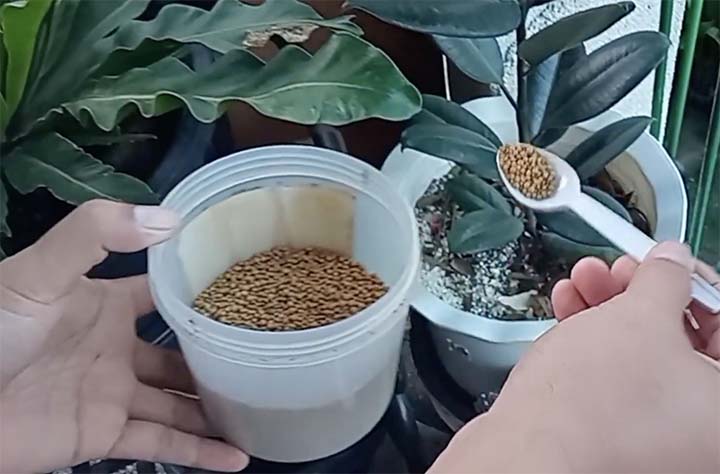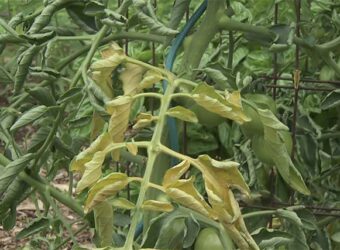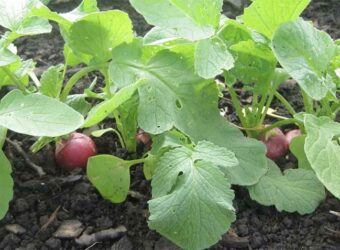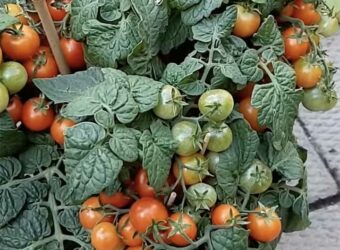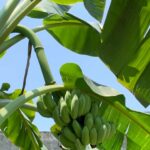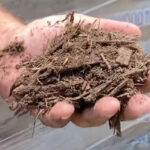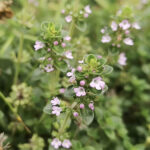When it comes to choosing a fertilizer for your plants, the options can be overwhelming! Not only are there many different types and formulations, but there are also various products within each category.
One type of balanced fertilizer is 14-14-14, also known as triple 14. This fertilizer supplies equal equivalents of the three macronutrients: nitrogen, phosphorus, and potassium.
We will provide more information about triple 14 fertilizer and then provide a few product recommendations for you to try at home.
What Is 14-14-14 Fertilizer?
Most fertilizers will contain three numbers on their packaging. These numbers explain the amount of the three plant macronutrients—nitrogen, phosphorus, and potassium— in the fertilizer.
While many people say these numbers refer to the percent of each element present in the fertilizer, this isn’t true. Instead, they refer to the percent of nitrogen as N, the percent of phosphorus as phosphate (P₂O₅), and the percent of potassium as potash (K₂O) by weight.
That means a 14-14-14 fertilizer contains 14% nitrogen, 14% phosphate, and 14% potash. In other words, it will supply similar amounts of nitrogen, phosphorus, and potassium to the soil.
When you add these three nutrients together, you find that they make up 42% of the product by weight. The other percent of the fertilizer may be filler or other nutrients.
It’s important to note that the 14-14-14 designation only reports on the number of macronutrients present. It does not tell you whether the fertilizer is synthetic or organic, nor does it provide any info about secondary nutrients and micronutrients.
While 14 may seem like a low number, it is a relatively high percentage when it comes to the amount of N, P, and K. In general, organic fertilizers cannot provide these high doses of nutrients.
Therefore, the majority of 14-14-14 fertilizers are synthetic. That means they are made from materials synthesized in a lab rather than naturally occurring materials.
The Importance of Nitrogen, Phosphorus, and Potassium
Before we dive into the uses of 14-14-14 fertilizer, let’s explore why these three nutrients are important to plants. As mentioned above, these three nutrients are known as macronutrients because plants need large amounts of each element to thrive.
Nitrogen
Nitrogen (N) is a major component of many plant structures, including structural proteins, enzymes, and chlorophyll. Therefore, nitrogen is involved in many different plant processes.
This element helps plants complete photosynthesis, take up water and nutrients, and regulate growth. If plants don’t have access to enough nitrogen, they may become stunted and yellow from a lack of chlorophyll.
On the other hand, too much nitrogen may cause lots of vegetative growth but a lack of flowers and fruits.
Phosphorus
Phosphorus (P) is a crucial part of the energy molecule ATP. When a plant needs energy to complete processes, an ATP molecule can release a phosphate molecule, thereby releasing energy stored in chemical bonds.
Phosphorus also makes up genetic material, such as DNA and RNA, that helps plants store and exchange information.
This nutrient also helps plants form seeds, develop strong roots, form flowers, and develop disease resistance.
Potassium
The final macronutrient, potassium, is not a structural component of plants. Instead, it acts as a chemical messenger within plants.
It helps move water and nutrients throughout the plant and also helps activate enzymes.
What Is 14-14-14 Fertilizer Used For?
You can use 14-14-14 fertilizer for crops that require a similar amount of the three macronutrients. While all plants require these nutrients, they don’t always require them in equal amounts.
Therefore, it’s best to use 14-14-14 fertilizer for crops that require equal amounts of these three nutrients. This includes vegetables like kale, swiss chard, carrots, beets, lettuce, and onions.
In general, you should avoid applying 14-14-14 to flowering crops. Instead, a fertilizer with more phosphorus and potassium than nitrogen is a better choice if you want to encourage the production of flowers and fruit.
Since 14-14-14 fertilizers provide relatively high doses of the three macronutrients, this fertilizer works well for plants that are heavy feeders. This includes leafy greens like spinach and kale, fruiting crops like tomato and peppers, and corn.
In general, I think 14-14-14 is a great fertilizer for a diverse vegetable garden. You can apply this fertilizer to all of your garden before planting then switch to a fertilizer designed for leafy greens or fruiting crops later on.
Types of 14-14-14 Fertilizer
When you start looking at 14-14-14 fertilizer, you’ll quickly see that many different options are available! While all of these products contain the same amount of nitrogen, phosphorus, and potassium, they may also have differences.
One aspect you should look at is whether the fertilizer is quick-release or slow-release.
Quick-release products supply all the nutrients to plants soon after you add the product to the soil. These products are great if your plant needs an immediate boost, but you will likely need to apply them regularly.
Slow-release products work just like they sound! Rather than releasing all the nutrients into the soil at one time, the nutrients slowly become available to plants over time. This means that you do not have to apply fertilizer as often, and the fertilizer may be less likely to wash away.
When it comes to choosing liquid or granular fertilizer, you’ll find that 14-14-14 fertilizer comes in granular form. That means you don’t have to choose between a solid and a liquid product.
Another aspect to look at is whether the fertilizer contains nutrients besides nitrogen, phosphorus, and potassium. Plants require 18 nutrients to thrive, and they typically take up 15 of these via their roots.
If you know your soil is deficient in a nutrient like calcium or sulfur, check to see if this nutrient exists in the 14-14-14 fertilizer you choose.
When and How to Apply 14-14-14 Fertilizer?
If you’re considering applying 14-14-14 fertilizer to your plants, you’ll want to ensure you follow proper application practices. Keep reading to learn more about how to apply 14-14-14 to specific types of plants.
Applying 14-14-14 Fertilizer to Lawns
While you can apply 14-14-14 fertilizer to grass lawns, a product with this NPK ratio isn’t the best choice. That’s because an equal amount of phosphorus can lead grass to produce pesky seedheads.
A better option is a product that contains high amounts of nitrogen, low amounts of phosphorus, and medium amounts of potassium. For example, fertilizers with NPK ratios of 16-0-8 and 22-4-10 are better options for lawns.
Applying 14-14-14 Fertilizer to Vegetable Gardens
Before you apply any fertilizer to your vegetable garden, you should be aware that different types of vegetables require different ratios and amounts of fertilizer! For example, leafy greens like spinach and kale require lots of all of the macronutrients, but they can benefit from a higher amount of nitrogen.
On the other hand, fruiting crops like peppers and tomatoes benefit from a fertilizer that contains higher amounts of phosphorus and potassium than nitrogen. However, a balanced fertilizer is a good choice for these plants when they are in their vegetative stage.
With all that said, if you only want to use one type of fertilizer for all of your vegetable crops, a 14-14-14 fertilizer can be a good option. It provides a sufficient amount of each macronutrient without overapplying one nutrient and underapplying the other.
You should begin applying 14-14-14 fertilizer to your vegetable garden in the early spring after you put the plants in the ground. Depending on the type of fertilizer you use, you may need to reapply the fertilizer a few months later.
You can consult Stephanie’s article for more fertilizer options when it comes to fertilizing your vegetable gardens.
Applying 14-14-14 Fertilizer to Houseplants
This type of fertilizer can work well for houseplants as long as you ensure you do not over-fertilize. Many houseplants are sensitive to chemicals, and applying too much fertilizer at once can result in fertilizer burn.
In general, you should apply 14-14-14 fertilizer to houseplants once in mid-spring. During this time, plants are resuming more rapid growth due to increasing daylight.
You should always follow product instructions to supply the correct dose of fertilizer for your houseplants. However, most products require that you apply about one to three tablespoons of fertilizer for a small to medium houseplant.
Depending on the type of plant and fertilizer, you may need to reapply fertilizer again in the late spring and mid-summer.
You should avoid applying fertilizer to houseplants in the fall and winter. During this time, plants are slowing their growth, so they do not require many nutrients.
Applying 14-14-14 Fertilizer to Trees
When trees are just getting established, they can benefit from regular fertilization. Fertilizing will help them put on new growth and develop a strong root system.
While a 14-14-14 fertilizer is better than no fertilizer, it’s not the best option. A better tree fertilizer will contain more nitrogen than phosphorus and potassium—a fertilizer with an NPK ratio in the ballpark of 16-4-4 is a better choice for trees.
How Long Does It Take Triple 14 Fertilizer to Work?
As mentioned above, not all types of triple 14 fertilizers are the same. Some supply all their nutrients immediately, and some slowly release them over time.
However, most 14-14-14 fertilizers will provide some plant-available nutrients as soon as you apply them.
With that said, if your plants show signs of nutrient deficiencies, don’t expect your plants to bounce back as soon as you apply triple 14 fertilizer. In general, you should begin to see your plants turn around within a few weeks of applying the fertilizer.
My Top Choices for Triple 14 Fertilizers
To be honest, I rarely use triple 14 fertilizers. That’s because I prefer organic options, and 14-14-14 fertilizers are usually synthetic products.
However, that’s not to say that triple 14 fertilizers are bad! They can provide your plants with the nutrients they need in a quick and easy way.
If you want to use a triple 14 fertilizer, check out one of the following products.
1. Osmocote Smart-Release Plant Food: Flower & Vegetable

If you’re looking for a 14-14-14 fertilizer for houseplants, flowers, and vegetables, check out Osmocote Smart-Release Plant Food. Like all triple 14 fertilizers, this product contains equal amounts of nitrogen, phosphorus, and potassium.
However, not all of these macronutrients exist in the same form. That’s because this product utilizes a special smart-release formula.
About 2% of each nutrient is available as soon as you apply the fertilizer to the soil. However, the other 12% of each nutrient is locked up in a granule that is coated with “semi-permeable resin.”
Water slowly enters the resin barrier and causes the nutrients to dissolve. As temperatures warm, the nutrients release into the soil for plants to take up. That means that plants have more access to nutrients in warmer weather, which is when they grow more quickly.
This slow-release formula not only means that the fertilizer applies nutrients for an extended period of time, but it also makes it difficult to burn your plants. Even if you apply more product than is recommended, only 1/7 of the nutrients will be available to the plant. The rest will slowly release over time.
Another great thing about Osmocote Smart-Release Plant Food is its easy application—simply sprinkle granules onto the soil and then water well. The package also has application directions for various vegetables, trees, shrubs, and bulbs.
It’s important to note that this product doesn’t contain many nutrients outside of nitrogen, phosphorus, and potassium. Therefore, you may need to apply another product to supply plants with nutrients like magnesium and sulfur.
2. Schultz Flower & Vegetable Extended Feed

If you can’t find Osmocote Smart-Release Flower & Vegetable or want an alternative option, check out Schultz Flower & Vegetable Extended Feed. This product provides an equal amount of nitrogen, phosphorus, and potassium in a granular form.
This product also utilizes a slow-release formula to release nutrients over multiple months. Therefore, you can apply fertilizer to the soil once and rest assured that it will continue to supply your plants with nutrients for up to six months.
The extended feed design also means that burning your plants with excessive fertilizer is almost impossible.
Applying this fertilizer is also low-mess and easy to apply. Simply shake the granules onto the soil surface and water well. Some nutrients will be immediately available to plants, and the rest will slowly release over time.
While this fertilizer contains all the macronutrients, it doesn’t contain other important nutrients like magnesium, calcium, and sulfur. Therefore, you will likely need to apply another fertilizer that supplies these nutrients.
So, what can you use Schultz Flower & Vegetable Extended Feed for? It can work well for vegetables, flowers, bulbs, shrubs, and trees.
In general, you’ll want to apply a larger amount of fertilizer to larger plants. However, the plant size will not affect how often you apply fertilizer.
Aim to apply fertilizer in the spring when the weather begins to warm and again in the summer, about three to four months after the first application. Typically, these two applications will be enough to support your plants throughout their active growth.
